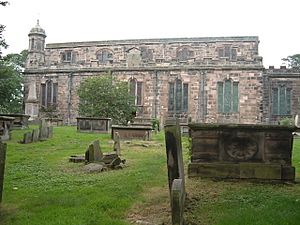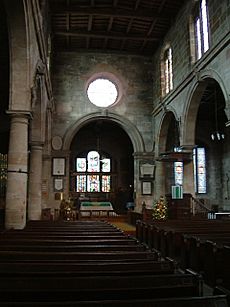Church of the Holy Trinity, Berwick-on-Tweed facts for kids
Quick facts for kids Holy Trinity Church,Berwick-on-Tweed |
|
|---|---|

Holy Trinity Church, Berwick-on-Tweed
|
|
| 55°46′19.04″N 2°0′2.2″W / 55.7719556°N 2.000611°W | |
| OS grid reference | NU 00030 53190 |
| Location | Parade, Berwick-upon-Tweed, Northumberland TD15 1DF |
| Country | England |
| Denomination | Church of England |
| Website | Berwick Parish Church, Holy Trinity with St. Mary |
| History | |
| Dedication | Holy Trinity |
| Consecrated | 1660 |
| Administration | |
| Parish | Berwick |
| Deanery | Norham |
| Archdeaconry | Lindisfarne |
| Diocese | Newcastle |
| Province | York |
The Church of the Holy Trinity is a special Church of England parish church located in the middle of Berwick-upon-Tweed, Northumberland. It is quite rare because it was built during a time in English history called the Commonwealth era.
Contents
History of the Church
Building the Church
In 1641, King Charles I provided money to replace the old, worn-out church in Berwick. However, the English Civil War began the very next year. Despite the war, more money was collected for the new church. Stones for building were even taken from the old Berwick Castle.
In 1650, a mason from London named John Young was hired to build the new church. By 1652, the church was finished. This makes it one of the very few churches built during the Commonwealth of England. Other examples include Ninekirks and St Matthias Old Church in Poplar, London.
Original Design and Changes
The church's design was inspired by St Katharine Cree in London. It has an aisle on each side of the main area, called the nave. The columns supporting the roof are in the Tuscan order style. When first built, the church did not have a chancel (the area around the altar), an altar, an organ, a tower, or bells. However, the inside of the church had galleries all around its four walls.
In 1660, two years after the king returned to power (this was called the Restoration of the Monarchy), John Cosin, who was the Bishop of Durham, officially opened the church. He insisted that a chancel should be built at the east end for the communion table. This change didn't happen until 1855. At that time, the current chancel was built, and many of the original Gothic windows were changed to a Classical style. The large window at the west end, added in 1855, is especially beautiful. It includes older 16th and 17th-century round glass pieces from a private chapel.
The Church Organ
Organ's Early Life
An organ was first put into the church in 1773 by Byfield and Green of London. Later, in 1855, Nicholson of Newcastle upon Tyne rebuilt it. Then, in 1869, another company called Harrison and Harrison rebuilt it again. They moved the organ to sit on either side of the west window in the west gallery.
In 1905, the north and south galleries were removed. Harrison and Harrison then moved the organ to where it is now, in a special room built just for it north of the chancel. In 1928, Ingrams did a full check-up and repair of the organ. In the late 1970s, the organist at the time tried to fix it, but it didn't go well.
Modern Restoration
The organ continued to be used until the early 2000s. The church then bought an electronic organ to use temporarily while they raised money to fix the old Harrison organ. By 2006, the fund to restore the organ reached £50,000. An Organ Restoration Group was formed to get quotes from three different companies that restore organs.
The group hired Paul Ritchie, who used to advise churches on organs, to help them. They chose Principal Pipe Organs of York to restore the organ. The work was planned to start in 2010. The group worked hard to raise £160,000 for the full restoration and for future care. The Berwick Parish Church Trust now looks after its maintenance. The restoration is now complete.
The organ originally had three keyboards (manuals) and pedals. However, during the restoration, it was changed to have two keyboards and pedals. Some people in Berwick-upon-Tweed felt it was a missed chance to fully restore the larger three-manual organ. The pipes from the choir organ section were mostly not original. Sadly, they were not considered good enough to be restored.
Current Use of the Church

Today, Holy Trinity Church is used for many things. People come for worship services, but it also hosts concerts, music recitals, lectures, and other community events. The church has a parish centre that is available for the community. It is used a lot for meetings and social gatherings. The old churchyard, which has many trees, is now a natural nature reserve.
There are two small turrets (small towers) at the west end of the church building. One of these turrets holds a single bell. This bell is rung to call people to church services.
The churchyard was the main burial ground for the town until around the 1860s. By then, there was no more space for burials. Now, Berwick and its nearby town, Tweedmouth, have their own separate cemeteries.

